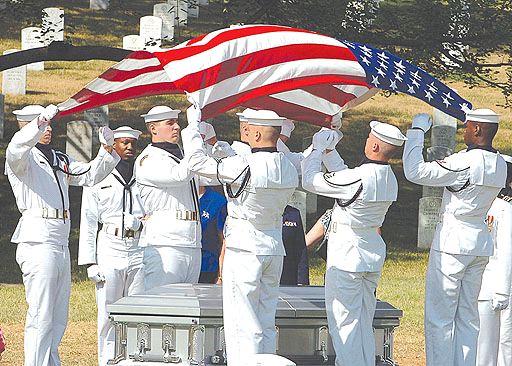Robert Warren Langwell
Indianapolis, Indiana
Born July 30, 1924
Ensign, U.S. Navy
Service Number 534047
Missing in Action – Presumed Dead
Died October 1, 1950 in Korea
Ensign Langwell served aboard the minesweeper, USS MAGPIE (AMS-25) in Korean waters.
On October 1, 1950, it struck a floating mine and sunk. Twenty one men were lost. He was listed as Missing in Action while engaged with the enemy. He was presumed dead on October 2, 1951. His remains were not recovered.
His name is inscribed on the Courts of the Missing at the Honolulu Memorial. Ensign Langwell was awarded the Purple Heart, the Combat Action Ribbon, the Korean Service Medal, the United Nations Service Medal, the National Defense Service Medal, the Korean Presidential Unit Citation and the Republic of Korea War Service Medal.
15 July 2010:
In the most solemn of ceremonies, a nearly sixty-year old chapter was closed when the remains of Ensign Robert Langwell was buried with full honors at Arlington National Cemetery July 12, 2010.
On October 1, 1950, Langwell was serving on the minesweeper USS Magpie when it sank after striking an enemy mine off the coast of Chuksan-ri, South Korea. Twelve crewmen were rescued, but Langwell was one of 20 men lost at sea.
Langwell’s remains were carried by a horse-drawn caisson through the cemetery, followed by family and friends, to his burial site in section 40. Naval District Washington’s U.S. Navy Ceremonial Guard, the U.S. Army’s ‘‘Old Guard” and the Navy Band came together to help lay Langwell to rest in providing the casket team, firing party, a bugler, escort troops and a band element.
After the firing party fired three rifle volleys, the casket team prepared the American flag to be presented to Langwell’s next of kin. Rear Admiral Jim Shannon presented the flag to Langwell’s aunt, Mary Parker. She also received personal hand-written notes of condolence from Lieutenant Colonel Judy Law of the Defense Prisoner of War Missing Personnel Office (DPMO) and Paula McKinley of the Navy Arlington Ladies. McKinley also presented official condolence cards from the Chief of Naval Operations and the Commandant of Naval District Washington.
In June 2008, personnel from the Republic of South Korea’s Ministry of National Defense Agency for Killed in Action Recovery and Identification (MAKRI) canvassed towns in South Korea in an effort to gather information regarding South Korean soldiers unaccounted-for from the Korean War. An elderly fisherman, interviewed in the village of Chuksan-ri, reported that he and other villagers had buried an American serviceman in 1950 when his body was caught in the man’s fishing net.
The MAKRI located the burial site on April 28, 2009, where they excavated human remains and military artifacts. The burial site was approximately three miles west of where the USS Magpie sank in 1950. The team turned the remains and artifacts over to U.S. Forces Korea, which sent them to Joint POW?MIA Accounting Command for analysis.
Among other forensic identification tools and circumstantial evidence, JPAC scientists used dental comparisons in the identification of Langwell’s remains.
According to DPMO, with Langwell’s accounting, 8,025 service members still remain missing from the Korean War.
Members of the U.S. Navy Ceremonial Guard prepare the flag for presentation during a burial with full honors for Ensign Robert Langwell at Arlington National Cemetery July 12. Langwell’s remains were recovered April 28, 2009 after being declared missing in action from the Korean War for nearly 60 years.
Michael Robert Patterson was born in Arlington and is the son of a former officer of the US Army. So it was no wonder that sooner or later his interests drew him to American history and especially to American military history. Many of his articles can be found on renowned portals like the New York Times, Washingtonpost or Wikipedia.
Reviewed by: Michael Howard

